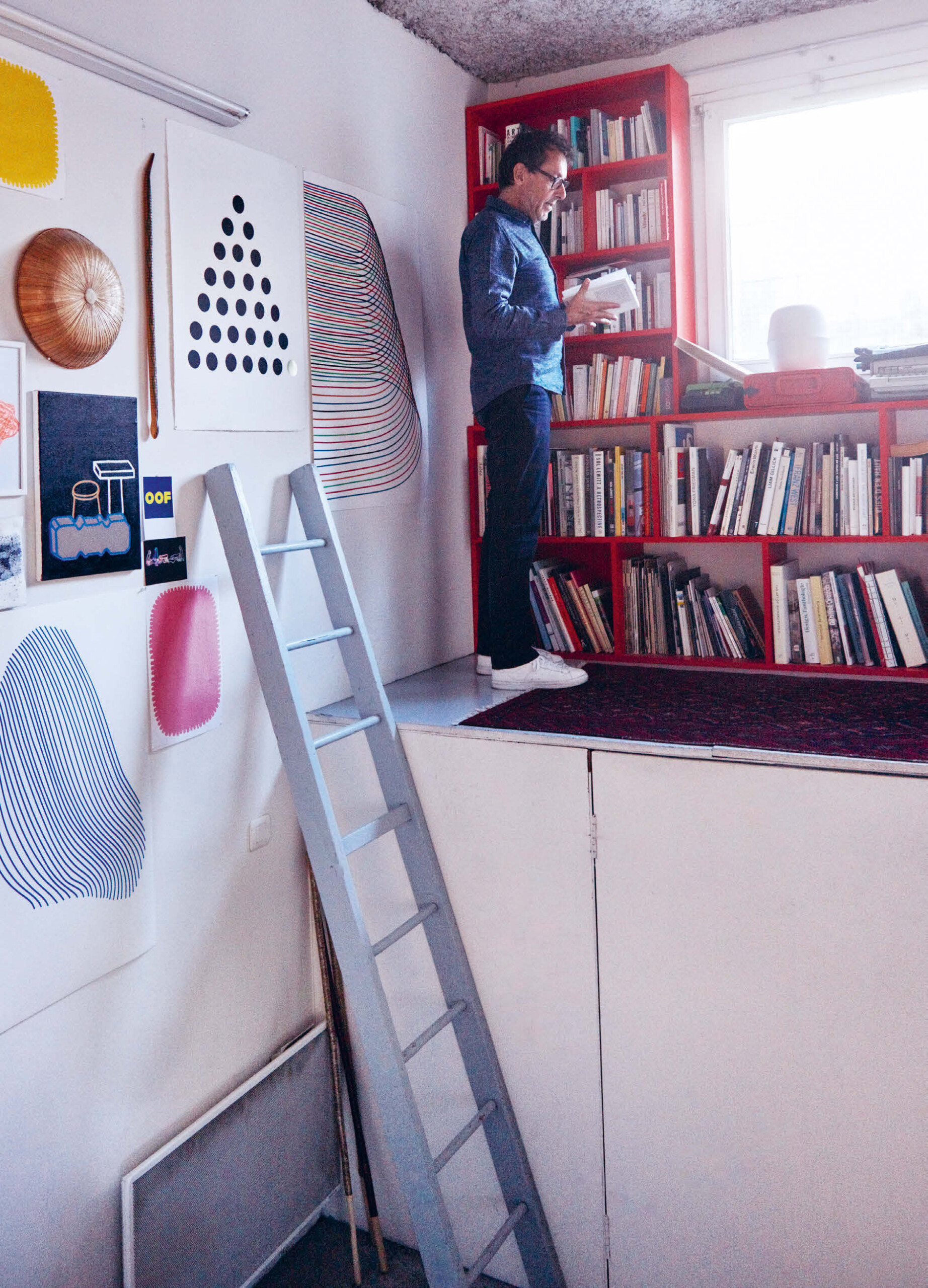A Studio Visit
in
P a r i s

E x t e r i o r
&
Interior
The journey by Paris metro to see Pierre Charpin is itself a kind of visual preface to his work. Instead of having his studio in the opulent bourgeois Paris of Haussmann, Charpin is based in the banlieue of Ivry, a modern social housing estate from the 1970s and 1980s. Designed by Renée Gailhoustet and Jean Renaudie, these housing complexes were once deemed a politically aware alternative to the grim massed apartment blocks of the post-war period that had previously been customary, yet had banished immigrants and low earners to the peripheries and turned city-dwellers into commuters. The stated purpose of these cubes of exposed concrete, stacked and twisted into pyramid shapes and forming a kind of Cubist mountain landscape with their greened terraces and occasional coloured balconies, lines of apartments straddling roads, covered passages and squares, communal areas and children’s playgrounds, was to reconcile working and living and lend a more human face to social housing. But not even the well-meant principle behind the architecture could hold back the passage of time. The estate has become dilapidated; the population no longer as diverse as it once was, and the prevailing mood is one of bleakness and neglect.
“I moved here with my parents in 1972”, recounts Pierre Charpin in his studio on the ground floor of a recently renovated tower block. The architects were friends of the family, and the move was a deliberate choice, an experiment in modern living. Jean Renaudie himself lived and worked in the building behind Charpin’s studio. In those days, the designer reminisces, his parents and their neighbours never bothered locking their front doors when they went out — unthinkable today. The residents from those early days are now old, or already dead, or — like Charpin’s parents — have moved away.
Charpin’s father created his sculptures in this studio. When the designer looks out of the window today, his gazes falls on colourful cylinders with openings redolent of James Turrell’s Skyspaces, blue concrete snakes and whimsically pierced geometric and graphic forms that are still characteristic of Charpin’s work today — a children’s playground designed by his father. “Oh yes, I definitely believe I’ve been affected by this environment”, he admits. Although the utopian pioneering spirit in the estate has long become a mere shadow of its former self, Pierre Charpin is still there. Asserting “I don’t find memories suffocating; they ground me”, he has retained his loyalty to Ivry, adopting it as his natural biotope.
The walls of Charpin’s studio speak volumes about his working methods. Every free surface is littered with small assemblies of objects; perhaps an autumn leaf picked up in the adjacent playground shortly before, or a simple plastic sieve from the Asian shop next door, rubbing shoulders with photographs, stones, oddly shaped cardboard boxes. These assemblies are like visual notes that form artistic compositions. On closer examination, we can trace how these notes were transformed into objects. Behind Charpin’s desk is a print of curving red lines, echoed in the Ruban vase he created for Galerie Kreo in Paris which is displayed on the shelf opposite. A drawing of a kind of folded rectangle reappears on a silk scarf recently designed for Hermès. The sketches, drawings and prints, more studies of form and colour than pictures in any conventional sense, are lent a personal, magic presence by their meticulous arrangements. “I developed a feel for scenography in Japan”, he explains. “In my view, the Japanese are masters of positioning, of the art of using space. They are experts in arranging objects while preserving the necessary distance.” Japan has been an obsession for Charpin since his first in-depth encounter with the country in 2012 — far too late, in his view — on a residence programme in Kyoto. Since then, it has irresistibly drawn him to return once a year.
Charpin’s most recent assembly of objects documents his latest or newly completed project. The iron piping, used in training by welding apprentices, is a ready-made artwork by Elvire Bonduelle, reminiscent of a machine-gun trained on a cotton bag from Kyoto. Next to it are a parking disc from Switzerland, a drawer handle that Charpin designed for Pamar, a sketched penknife design for Alessi and a shard of his latest dinner service designed for Japanese ceramics manufacturer Arita. The package of plates and bowls, fresh off the production line, has just arrived from Japan. In front stands a prototype of PC Lamp, his desk lamp for Hay, which is being expanded into a whole collection to be launched next spring.
Please select an offer and read the Complete Article Issue No 6 Subscriptions
Already Customer? Please login.
